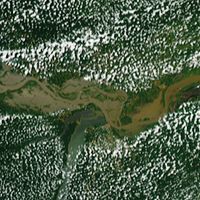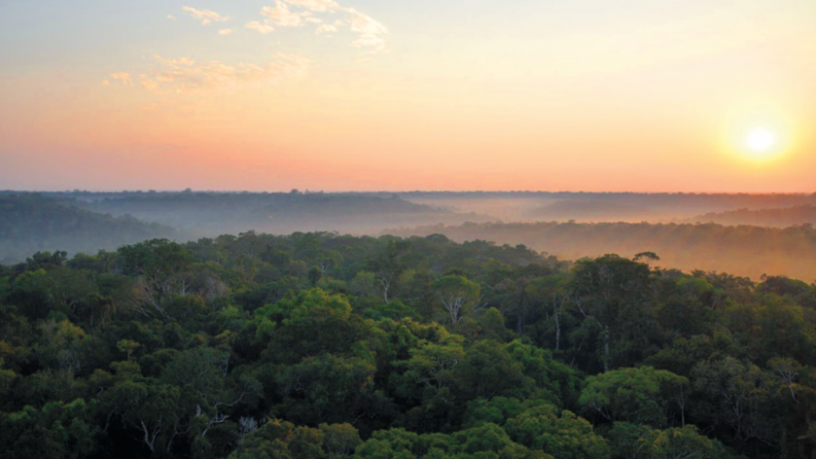A New Approach to Modeling Amazon Seasonal Cycles
Sometimes, taking an approach that is opposite to conventional practice can lead to breakthrough science. That’s the case in a research partnership between Pierre Gentine and Adam Sobel. The two have collaborated to develop a new simulation strategy that more accurately models Amazon seasonal cycles. This simulation strategy gives deeper insight into the water and carbon cycles of the Amazon rain forest and better understanding of tropical climates overall.

Aerial view of the Amazon rain forest during its dry season (Image courtesy of NASA)
Detailed in a paper published in January in Proceedings of the National Academy of Sciences, the strategy is opposite to current climate models and employs Sobel’s weak temperature gradient (WTG) approximation, which had only ever been used for simulations over the ocean. The paper’s first author is Usama Anber, Sobel’s recently graduated PhD student at Columbia’s Lamont-Doherty Earth Observatory.
“Pierre knew about the land-atmosphere interactions in the Amazon, while my team knew how to simulate tropical weather using the WTG methods in a cloud-resolving model,” explains Sobel, professor of applied physics and applied mathematics, who has a joint appointment in earth and environmental sciences. “We didn’t know if this approach would work, but it was worth a try.”
Climate modeling of tropical rain forests like the Amazon has been problematic in the past because it can be difficult to mathematically represent the delicate interplay of natural variables in the region.
“Water vapor, clouds, and radiation interact with the large-scale circulation of the atmosphere to produce the complex patterns of tropical weather and climate. Making sense of these interactions requires us to piece together processes at multiple scales, since clouds are small while the global tropical circulation is huge,” says Sobel.
Chief among inaccuracies of traditional approaches used to model the climate in the Amazon has been a mix-up in modeling the correct seasons for peak evaporation and photosynthesis rates.
“There are certain biases in traditional climate models that typically mix the subtleties of the Amazon wet and dry seasons,” says Pierre Gentine, assistant professor of earth and environmental engineering.
But the new modeling approach is able to effectively simulate the climate of the Amazon, where the land and atmosphere interact in a feedback loop that determines the seasonality of precipitation and surface evaporation. That’s important in helping better understand what controls climate in the Amazon and predict future climatic conditions for an area that has a big influence on the global climate. For example, the Amazon exchanges vast amounts of water and energy with the atmosphere and ocean, and regulates weather. It also replenishes, redistributes, and purifies much of the world’s natural water resources and influences the circulation of ocean currents. Moisture created in the Amazon ends up falling as rain as far away as Texas. And because the Amazon absorbs 1.4 billion tons of CO2 annually, it helps reduce global warming by lowering the earth’s levels of greenhouse gases. Without that crucial modeling, it’s difficult to understand what factors are affecting climate changes in the tropics—and elsewhere.

Morning fog plays a key role in regulating evaporation and surface radiation in the wet season. (Photo courtesy of Xi Yang)
The model already has shown the key role that morning fog plays in regulating evaporation and surface radiation. Morning fog is present in the Amazon’s wet season but absent in the dry season.
“Fog is very important because it shades the surface, so plants have less sunlight. That factor controls the seasonal cycle of the Amazon,” explains Gentine. “This helps us better understand the carbon cycle as well. In the dry season, when there is no morning fog, plants receive more sunlight, thereby increasing evaporation and photosynthesis rates and using more carbon dioxide.”
Sobel and Gentine now plan to use the new modeling approach to examine the carbon cycle, to see if they can better predict climate change in the continental tropics. Their approach allows them to simulate the ways in which CO2 exchange at the land surface is related to clouds and atmospheric dynamics.
“How climate change plays out in the tropics depends on the interaction of clouds and the large-scale circulation. This is a fascinating puzzle, and our simulation strategy was designed specifically to help us solve it,” says Sobel.

Adam Sobel (left) and Pierre Gentine (Photo by Jeffrey Schifman)
